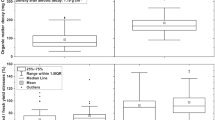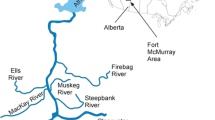Abstract
Purpose
The organic content in urban sewer sediment can significantly influence sediment erosion behavior because of biological activity. In this experimental study, the erosion behavior of sediments with different organic content was investigated to develop a mathematical relationship between the critical shear stress and biological activities.
Materials and methods
Before testing, sediment samples were incubated under two environmental conditions: aerobic conditions with high biological activities and sterile conditions with low biological activities. With different incubation periods, samples were subjected to the scouring test in an open channel flume, by which the incipient motion of sediments was determined.
Results and discussion
Experimental results show that the sediment erosion resistance is simultaneously subject to the strengthening and the weakening effect induced by the biological activity, which is dependent on the incubation period and organic content. For low organic content sediment (volatile solids content < 4%), the biological activity can strengthen the sediment erosion resistance and increase τc, while τc of higher organic content sediment is distinctly reduced.
Conclusions
The biological activity can both strengthen and weaken the sediment erosion resistance. The strengthening effect is attributed to the biofilm formation in the biological activity, whereas the weakening effect is due to the sediment volume expansion by the gas bubble formation. These effects depend on the incubation period and organic content within sediments, which can be used to predict the incipient motion of sediments by modifying the biological influence coefficient. Finally, Shields curves were modified to account for the biological activity.









Similar content being viewed by others
References
Ahimou F, Semmens MJ, Haugstad G, Novak PJ (2007) Effect of protein, polysaccharide, and oxygen concentration profiles on biofilm cohesiveness. Appl Environ Microbiol 73:2905–2910. https://doi.org/10.1128/aem.02420-06
Avnimelech Y, Ritvo G, Meijer LE, Kochba M (2001) Water content, organic carbon and dry bulk density in flooded sediments. Aquac Eng 25:25–33
Banasiak R, Verhoeven R, De Sutter R, Tait S (2005) The erosion behaviour of biologically active sewer sediment deposits: observations from a laboratory study. Water Res 39:5221–5231
Boudreau BP, Algar C, Johnson BD, Croudace I, Reed A, Furukawa Y, Dorgan KM, Jumars PA, Grader AS, Gardiner BS (2005) Bubble growth and rise in soft sediments. Geology 33:517–520
Butler D, May R, Ackers J (2003) Self-cleansing sewer design based on sediment transport principles. J Hydraul Eng-ASCE 129:276–282
Cheng W, Fang H, Lai H, Huang L, Dey S (2018) Effects of biofilm on turbulence characteristics and the transport of fine sediment. J Soils Sediments 18:3055–3069. https://doi.org/10.1007/s11368-017-1859-1
Chenu C, Guerif J (1991) Mechanical strength of clay minerals as influenced by an adsorbed polysaccharide. Soil Sci Soc Am J 55:1076–1080
Chien N, Wan Z (1999) Mechanics of sediment transport. American Society of Civil Engineers, Reston, Virginia
Cui L, Chen P, Zhang B, Zhang D, Li J, Martin FL, Zhang K (2015) Interrogating chemical variation via layer-by-layer SERS during biofouling and cleaning of nanofiltration membranes with further investigations into cleaning efficiency. Water Res 87:282–291. https://doi.org/10.1016/j.watres.2015.09.037
David V, Davidova T (2013) Estimations of discharge values for purposes of surface runoff and sediment transport off-site effects assessment. In: EGU 2013 General Assembly Conference Abstracts, Vienna
Fang H, Shang Q, Chen M, He G (2014) Changes in the critical erosion velocity for sediment colonized by biofilm. Sedimentology 61:648–659
Fang H, Fazeli M, Cheng W, Huang L, Hu H (2015) Biostabilization and transport of cohesive sediment deposits in the Three Gorges Reservoir. PLoS One 10:e0142673
Flemming H-C, Wingender J (2010) The biofilm matrix. Nat Rev Microbiol 8:623–633
Gerbersdorf SU, Jancke T, Westrich B, Paterson DM (2008) Microbial stabilization of riverine sediments by extracellular polymeric substances. Geobiology 6:57–69
Gouda H, Ashley RM, Gilmour D, Smith H (2003) Life cycle analysis and sewer solids. Water Sci Technol 47:185–192
Guo Q, Fan C-Y, Raghaven R, Field R (2004) Gate and vacuum flushing of sewer sediment: Laboratory testing. J Hydraul Eng-ASCE 130:463–466
Hagadorn JW, Mcdowell C (2012) Microbial influence on erosion, grain transport and bedform genesis in sandy substrates under unidirectional flow. Sedimentology 59:795–808
Israelachvili JN (1992) Intermolecular and surface forces: with applications to colloidal and biological systems (Colloid Science). Academic Press Inc, London
Lick W, Jin L, Gailani J (2004) Initiation of movement of quartz particles. J Hydraul Eng-ASCE 130:755–761
Liu X-M, Sheng G-P, Luo H-W, Zhang F, Yuan S-J, Xu J, Zeng RJ, Wu J-G, Yu H-Q (2010) Contribution of extracellular polymeric substances (EPS) to the sludge aggregation. Environ Sci Technol 44:4355–4360. https://doi.org/10.1021/es9016766
Liu F, Zhang J, Lu X, Zhong H (2012) Influence of water treatment agent on the efficiency of intermittent activated sludge treatment system. Pet Process Petrochem 43:92–96 (in Chinese)
Loucks DP, Van Beek E (2017) Water resource systems planning and management: An introduction to methods, models, and applications. Springer
Ma Y (2014) Study on erosion characteristics and transport principles of sewer sediment in sewerage system. MSc thesis, Zhejiang University (in Chinese)
Ma Y, Lei T, Zhang X, Chen Y (2013) Volume replacement method for direct measurement of soil moisture and bulk density. Trans Chinese Soc Agric Engineer 29:86–93. https://doi.org/10.3969/j.issn.1002-6819.2013.09.012 (in Chinese)
Malarkey J, Baas JH, Hope JA, Aspden RJ, Parsons DR, Peakall J, Paterson DM, Schindler RJ, Ye L, Lichtman ID (2015) The pervasive role of biological cohesion in bedform development. Nat Commun 6:6257
Ota JJ, Perrusquia GS (2013) Particle velocity and sediment transport at the limit of deposition in sewers. Water Sci Technol 67:959–967
Piqué G, Vericat D, Sabater S, Batalla RJ (2016) Effects of biofilm on river-bed scour. Sci Total Environ 572:1033–1046
Quaresma VS, Amos CL, Flindt M (2004) The influences of biological activity and consolidation time on laboratory cohesive beds. J Sediment Res 74:184–190
Roberts J, Jepsen R, Gotthard D, Lick W (1998) Effects of particle size and bulk density on erosion of quartz particles. J Hydraul Eng-ASCE 124:1261–1267
Seco I, Gómez Valentín M, Schellart A, Tait S (2014) Erosion resistance and behaviour of highly organic in-sewer sediment. Water Sci Technol 69:672–679
Seco I, Schellart A, Gómez-Valentín M, Tait S (2018) Prediction of organic combined sewer sediment release and transport. J Hydraul Eng-ASCE 144:04018003. https://doi.org/10.1061/(ASCE)HY.1943-7900.0001422
Shahsavari G, Arnaud-Fassetta G, Bertilotti R, Campisano A, Riou F (2015) Bed evolution under one-episode flushing in a truck sewer in Paris, France. Int J Civil Environ Struct Construct Architect Eng 9:868–878
Shao W, Ma Y, Zhou Y, Xu D, Yao G (2014) Erosion characteristics of sewer sediment with biological actions. J ZheJiang Univ (Engineering Science) 48:1075–1079. https://doi.org/10.3785/j.issn.1008-973X.2014.06.015 (in Chinese)
Shi C-X, You L-Y, Li B-Y (2003) Natural consolidation of deposits and its consequences at the Yellow River Delta. Sci Geogr Sin 23:174–181 (in Chinese)
Sutherland T, Amos C, Grant J (1998) The effect of buoyant biofilms on the erodibility of sublittoral sediments of a temperate microtidal estuary. Limnol Oceanogr 43:225–235
Tang Y, Zhu DZ, Rajaratnam N, van Duin B (2020) Sediment depositions in a submerged storm sewer pipe. J Environ Eng:146
Tolhurst T, Consalvey M, Paterson D (2008) Changes in cohesive sediment properties associated with the growth of a diatom biofilm. Hydrobiologia 596:225–239
Ubertini M, Lefebvre S, Rakotomalala C, Orvain F (2015) Impact of sediment grain-size and biofilm age on epipelic microphytobenthos resuspension. J Exp Mar Biol Ecol 467:52–64
Van Colen C, Underwood GJ, Serôdio J, Paterson DM (2014) Ecology of intertidal microbial biofilms: mechanisms, patterns and future research needs. J Sea Res 92:2–5
Vignaga E, Sloan DM, Luo X, Haynes H, Phoenix VR, Sloan WT (2013) Erosion of biofilm-bound fluvial sediments. Nat Geosci 6:770–774
Vollertsen J, Hvitved-Jacobsen T (2000) Resuspension and oxygen uptake of sediments in combined sewers. Urban Water J 2:21–27. https://doi.org/10.1016/S1462-0758(00)00036-4
Wang H, Tang H-w, Zhao H-q, Zhao X-y, Lü S-q (2015) Incipient motion of sediment in presence of submerged flexible vegetation. Water Sci Eng 8:63–67. https://doi.org/10.1016/j.wse.2015.01.002
Wang X-X, Zhang T-Y, Dao G-H, Hu H-Y (2018) Tolerance and resistance characteristics of microalgae Scenedesmus sp. LX1 to methylisothiazolinone. Environ Pollut 241:200–211
Xu Z, Wu J, Li H, Liu Z, Chen K, Chen H, Xiong L (2017) Different erosion characteristics of sediment deposits in combined and storm sewers. Water Sci Technol 75:1922–1931
Yang F-g, Liu X-n, Cao S-y, Huang E, Yang K-j (2010) An uniform formulation of the Shields diagram and its application in the scouring prevention of Tangjiashan barrier lake downstream channel. J Sichuan Univ (Engineering Science Edition) 42:175–179 (in Chinese)
Zhong X, Wu Y (2013) Bioclogging in porous media under continuous-flow condition. Environ Earth Sci 68:2417–2425
Zhou Y, Chen Y, Shao W (2014) Field study of dynamic behaviour of sediment in combined sewer overflow chambers. P I Civil Eng-Wat Mt 167:489–498. https://doi.org/10.1680/wama.13.00027
Zhou Y, Ma Y, Fang L, Guo Y (2016) Impacts of biological activities on erosion of sewer sediments. P I Civil Eng-Wat Mt 169:43–52. https://doi.org/10.1680/wama.14.00134
Acknowledgements
The Project was supported by National Natural Science Foundation of China (51878597, 51908493), and the Fundamental Research Funds for the Central Universities (2019QNA4035).
Author information
Authors and Affiliations
Corresponding author
Ethics declarations
Conflict of interest
The authors declare that they have no conflict of interest.
Additional information
Responsible editor: Sabine Gerbersdorf
Publisher’s note
Springer Nature remains neutral with regard to jurisdictional claims in published maps and institutional affiliations.
Electronic supplementary material
ESM 1
(DOCX 516 kb)
Rights and permissions
About this article
Cite this article
Zhou, Y., Yao, X., Gu, Y. et al. Biological effects on incipient motion behavior of sediments with different organic matter content. J Soils Sediments 21, 627–640 (2021). https://doi.org/10.1007/s11368-020-02807-9
Received:
Accepted:
Published:
Issue Date:
DOI: https://doi.org/10.1007/s11368-020-02807-9




